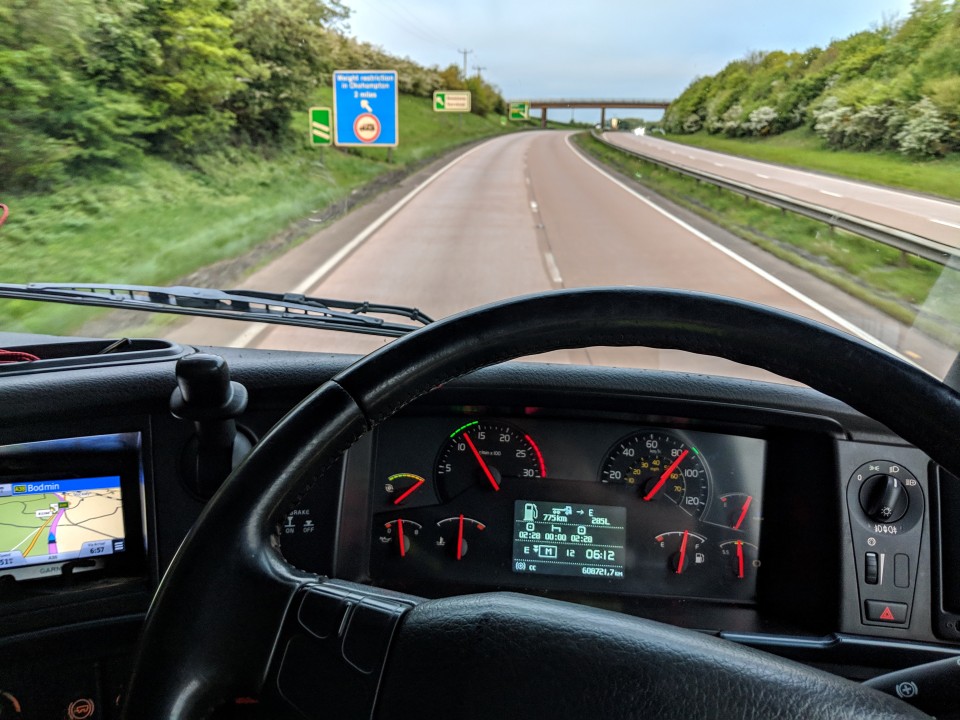
Susie Jones
Lengvai suprantamos tachografų taisyklės
Sukurta: 01-08-2024
•
Atnaujinta: 08-08-2024
Tachografų taisyklių pasaulis gali būti painus net ir labiausiai patyrusiam sunkvežimio vairuotojui. Ką jau kalbėti apie naujus vairuotojus. Siekiame išaiškinti kai kuriuos neaiškumus.
Kas yra tachografas ir kodėl jį turime?
Pasak žodyno, tachografas - tai "prietaisas, įmontuotas į transporto priemones, pavyzdžiui, sunkvežimius ir tolimojo susisiekimo autobusus, kad būtų galima užrašyti informaciją, pavyzdžiui, kokiu greičiu važiuoja transporto priemonė, kokį atstumą nuvažiuoja ir kiek pertraukų daro vairuotojas".
Tachografo paskirtis - užkirsti kelią vairuotojų nuovargiui ir užtikrinti, kad vairuotojai ir darbdaviai laikytųsi taisyklių. [Labdaros organizacija "Brake" (https://www.brake.org.uk/get-involved/take-action/mybrake/knowledge-centre/driver-fatigue) pranešė, kad "keturiose iš dešimties su nuovargiu susijusių avarijų dalyvauja komercinę transporto priemonę vairuojantis asmuo". Todėl tachografų taisyklės yra labai svarbios siekiant sumažinti šį skaičių.
Kada jums reikia tachografo?
Tachografą reikia įsidiegti, jei jūsų transporto priemonės bendroji masė viršija tris su puse tonos. Svarbu prisiminti, kad tai apima ir priekabos vilkimą. Yra keletas šios taisyklės išimčių:
Jei vairuojate tik viešuosiuose keliuose
Jei transporto priemonę vairuoja ginkluotosios pajėgos, policija arba ugniagesiai.
Jei esate komercinis transporto priemonių parkas ir naudojate transporto priemones, kurių maksimalus svoris neviršija septynių su puse tonos, o jūsų kelionė yra nutolusi mažiau nei 100 km nuo jūsų veiklos bazės.
Jei vežate krovinius ir jūsų transporto priemonė yra elektrinė
Jei vežate vairuotojo naudojimui skirtą įrangą ar mašinas ir šios transporto priemonės vairavimas nėra pagrindinis jūsų darbas.
Kokie yra skirtingi tachografų tipai?
Yra trys skirtingi tachografų tipai:
Analogas: Europoje jie privalomi nuo 1986 m. Analoginiuose tachografuose vairuotojo duomenims įrašyti naudojami vaškinio popieriaus lapai. Vairuotojai rankiniu būdu įveda duomenis ir įdeda juos į tachografo įrenginį.
Skaitmeninis: Jie buvo pradėti naudoti 2006 m. Jais naudojasi daugiau kaip milijonas transporto įmonių ir daugiau kaip šeši milijonai profesionalių vairuotojų. Skaitmeniniai tachografai vairuotojo duomenis įrašo į vidinę atmintinę ir vairuotojo kortelę.
Išmanusis: Europos Sąjunga reikalauja, kad nuo 2019 m. birželio mėn. įmonės naudotų išmaniuosius tachografus. Jie automatiškai fiksuoja transporto priemonės buvimo vietą kiekvienos kelionės pradžioje ir pabaigoje. Jie taip pat kas tris valandas pateikia atnaujintus duomenis
Ką reiškia kiekvienas tachografo simbolis?
Peržiūrėkite mūsų [vaizdo įrašą] (https://www.youtube.com/watch?v=dgqGmlu9LfM&t=3s), kuriame paaiškinamas kiekvienas tachografo simbolis.
Pažeiskite taisykles
Siekiant užtikrinti sunkvežimio vairuotojo ir visų kitų kelyje esančių asmenų saugumą, būtina laikytis pertraukų taisyklių. Suskirstėme pagrindinius punktus.
Važiavimo laikas:
- Iki pertraukos negali būti ilgesnis nei keturios su puse valandos
Pertraukos:
- Turi būti ne trumpesnės kaip 45 minutės, išskyrus atvejus, kai vairuotojas naudojasi poilsio pertrauka
Poilsio laikotarpis:
- Per poilsio laikotarpį negalima vairuoti ar dirbti bet kokio kito darbo.
Skirstymo pertraukos:
Visą 45 minučių pertrauką galima padalyti į 15 minučių pertrauką, po kurios seka 30 minučių pertrauka.
Pertraukos turi būti paskirstytos per keturias su puse valandos vairavimo laiko.
Pagal ES taisykles, jei pertraukos yra dalijamos, antroji pertrauka turi būti ne trumpesnė kaip 30 minučių.

Dienos vairavimo limitas
Dienos vairavimo riba reiškia maksimalų vairavimo laiką per dieną. Maksimali trukmė yra devynios valandos, tačiau ją galima padidinti iki 10 valandų. Tačiau tai negalima daryti daugiau kaip du kartus per nustatytą savaitę. Dienos vairavimo trukmę galima apibrėžti taip:
Bendras sukauptas vairavimo laikas nuo kasdienio poilsio laikotarpio pabaigos iki kito kasdienio poilsio laikotarpio pradžios
Bendras sukauptas vairavimo laikas nuo kasdienio poilsio laikotarpio iki savaitinio poilsio laikotarpio. .
Savaitės ir dviejų savaičių vairavimo limitas
Vairuotojai turi užtikrinti, kad neviršytų maksimalaus savaitės ir dviejų savaičių vairavimo limito.
Maksimalus savaitės vairavimo limitas yra 56 valandos (taikoma fiksuotai savaitei).
Nustatyta savaitė prasideda 00.00 val. ir baigiasi kitą sekmadienį 24.00 val.
Dviejų savaičių vairavimo trukmė yra 90 valandų.
Dienos poilsis
Be to, reikia kasdien ilsėtis.
Vairuotojas turi nepertraukiamai ilsėtis 11 valandų. Ši trukmė gali būti sutrumpinta iki devynių
Šis sumažėjimas gali būti atliekamas tik iki trijų kartų tarp savaitinių poilsio laikotarpių.
Poilsio laikotarpis turi būti baigtas per 24 valandas nuo paskutinio dienos ar savaitės poilsio laikotarpio pabaigos.
Kasdien ilsėtis galima automobilyje, tačiau būtina turėti tinkamas miegojimo vietas. Jei tokių patalpų nėra, vairuotojas turi susirasti nakvynę. Norėdami sužinoti, kuriose sunkvežimių stotelėse teikiama ši paslauga, apsilankykite mūsų puslapyje vietos.
Savaitės poilsis
Savaitės poilsio laikotarpiai turi būti suteikiami ne vėliau kaip pasibaigus šešiems iš eilės 24 valandų laikotarpiams nuo paskutinio savaitinio poilsio pabaigos.
Vairuotojai privalo ilsėtis ne mažiau kaip 45 valandas.
Jie gali sutrumpinti savaitės poilsio laiką bent 24 valandomis.
Sutrumpintas savaitės poilsis turi būti kompensuojamas vienu bloku ir ne mažiau kaip devyniomis valandomis iki trečiosios savaitės pabaigos.
Nors sutrumpintą poilsio laiką galima naudoti, verta atkreipti dėmesį, kad per dvi iš eilės einančias savaites, kai buvo naudojamas sutrumpintas poilsio laikas, viena iš jų turi trukti 45 valandas.

Daugiafunkcinis personalas
Kai kurie vairuotojai gali vežti kitą vairuotoją. To nauda - didesnis našumas, didesnis nuvažiuotų kilometrų skaičius ir ilgesnis vairavimo laikas.
Abu vairuotojai privalo kasdien ilsėtis devynias valandas.
Šis kasdienis poilsis turi būti atliekamas ne per 24, o per 30 valandų.
Pirmąją valandą, kai važiuojama keliais, kito vairuotojo nereikia. Po valandos jis tampa privalomas.
Kėlimasis keltais arba kelionė traukiniu
Kaip minėta pirmiau, vairuotojo kasdienio poilsio trukmė turi būti 11 valandų nepertraukiamai, tačiau yra keletas šios taisyklės išimčių. Jei transporto priemonę lydi vairuotojas; kasdienio poilsio laikas gali būti nutrauktas du kartus, tačiau iš viso neturi viršyti vienos valandos. Pavyzdžiui, įlipimas ir išlipimas iš keltų ir traukinių.
Jei įprastas kasdienio poilsio laikas tokiu būdu nutraukiamas, bendras poilsio laikas turi būti ne trumpesnis kaip 11 valandų arba 12 valandų, jei jis dalijamas.
Kas yra vienos minutės tachografo taisyklė?
Vienos minutės taisyklė įsigaliojo 2011 m. spalio mėn. Ji susijusi su senesniais teisės aktais, kuriuose buvo išsamiai nurodyta, kad minutė, kurioje vairavimo laikas yra ne trumpesnis kaip penkios sekundės, turi būti registruojama kaip vairavimo laikas. Tačiau ES pakeitė šiuos teisės aktus, todėl viena ilgiausia nepertraukiama veikla, atlikta per minutę, bus registruojama kaip konkreti veikla.
Kas nutiktų, jei nesilaikyčiau tachografo taisyklių?
Už tachografo taisyklių nesilaikymą gali būti skiriamos baudos, o kartais ir laisvės atėmimo bausmė. Paprastai bausmė priklauso nuo pažeidimo sunkumo. Už daugumą tachografo taisyklių pažeidimų skiriamos fiksuotos baudos. Vairuotojai turi iki 28 dienų apsvarstyti fiksuotas nuobaudas.
Jungtinėje Karalystėje skiriamos dviejų rūšių baudos ir nuobaudos.
Ketvirto lygio bauda: jos viršutinė riba yra 2500 svarų sterlingų; ši riba taikoma kiekvienai tachografo baudai. Tačiau tais atvejais, kai padaromi keli ketvirto lygio pažeidimai, gali būti skiriama maksimali bauda už kiekvieną pažeidimą.
Penktojo lygio bauda: jos dydis neviršija 5 000 svarų sterlingų, tačiau, kaip ir ketvirtojo lygio baudų atveju, už kelis pažeidimus gali būti skiriama didžiausia bauda.
Tachografo taisykles gali būti sudėtinga suprasti. Tačiau jų nesilaikymas gali sukelti saugos problemų ir galimas baudas. Suprasdami taisykles ir jų laikydamiesi, automobilių parkai ir vairuotojai gali saugiai ir teisėtai eksploatuoti savo transporto priemones. Labai svarbu atkreipti dėmesį į tai, kad tachografų taisyklės ir reglamentai gali skirtis priklausomai nuo šalies.



